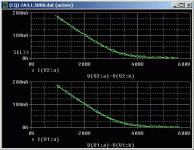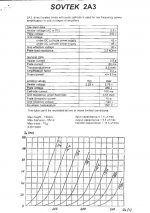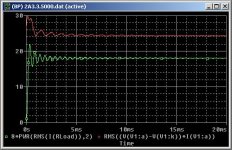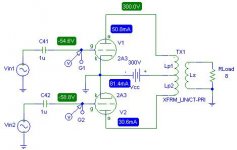Thank you ..
James, I already knew those curves, and, using them, I have "built", using SPICE, my PP amplifier. My problem is that I don't know the maximum plate voltage, current, power and so on ...
Everyone says that they are quite a 300B, but I cannot find anywhere anything supporting this statement.
Thanks again
James, I already knew those curves, and, using them, I have "built", using SPICE, my PP amplifier. My problem is that I don't know the maximum plate voltage, current, power and so on ...
Everyone says that they are quite a 300B, but I cannot find anywhere anything supporting this statement.
Thanks again
FWIW JC says that the Sovtek 2A3 cathode is just a 2A3 cathode - so running at 300B currents is not a good idea. Overvoltage is a different issue. Sovtek seem very reluctant to recommend any kind of abuse which is probably understandable. I have run mine at 27-28W over extended periods of time (years) with no ill effects.
> a Sovtek 2A3 "living" on these Load Lines, will die ?
It should not.
RCA 1937 says 300V maximum "Design Center". This includes allowance for utility power and other variation. In the 1950s, RCA re-rated tubes as "Design Maximum", which must not be exceeded. The "Maximum" ratings were usually 10%-20% higher than the "Center" ratings. So your 325V "should" be OK, but don't go much higher.
Your dissipation curves are low on average, but cross the original 15 Watt rating. We rarely did this in the old days. However, speech/music should not be a problem this way. The time spent around 200V 100mA 20 Watts is too short to cook the plate. And analog_sa says much higher average dissipation is possible on the Sovtek 2A3s.
But consider this. Dropping plate voltage to 300V gives a very safe operating point, with only about 1dB less power. Will you notice 1dB less power?
It should not.
RCA 1937 says 300V maximum "Design Center". This includes allowance for utility power and other variation. In the 1950s, RCA re-rated tubes as "Design Maximum", which must not be exceeded. The "Maximum" ratings were usually 10%-20% higher than the "Center" ratings. So your 325V "should" be OK, but don't go much higher.
Your dissipation curves are low on average, but cross the original 15 Watt rating. We rarely did this in the old days. However, speech/music should not be a problem this way. The time spent around 200V 100mA 20 Watts is too short to cook the plate. And analog_sa says much higher average dissipation is possible on the Sovtek 2A3s.
But consider this. Dropping plate voltage to 300V gives a very safe operating point, with only about 1dB less power. Will you notice 1dB less power?
FWIW,
I have been running sovtek 6B4G's at ~350V a-k, and a good 75mA current.
Theses things are robust. They've been running like this for over 2yrs. I would consider 30W as the max plate dissipation. I think the cathode does output a bit more current than vintage 2A3's, but its not at the level of a 300B.
A hell of a nice current production tube. Half the price of russian 300B's, too.
share and enjoy
I have been running sovtek 6B4G's at ~350V a-k, and a good 75mA current.
Theses things are robust. They've been running like this for over 2yrs. I would consider 30W as the max plate dissipation. I think the cathode does output a bit more current than vintage 2A3's, but its not at the level of a 300B.
A hell of a nice current production tube. Half the price of russian 300B's, too.
share and enjoy
RCA 1937 says 300V maximum "Design Center".
Type numbers these days bear little relationship to traditional performance specs for these tubes. It's something that bothers me deeply- a "572B" or "2A3" or "300B" is more of a brand than anything resembling a uniform performance spec. I've got some Svetlana 572B on hand that come in three mus- 3, 10, and 30. None of which correspond to the "official" mu of type 572B. And the pinout is different, too, just to add insult to injury.
So it seems to be with 2A3- what you and I think of as "2A3" is not generally what is sold (except as NOS) as 2A3, other than the accident of a filament cathode and more-or-less three active elements.
edit: Comparing curves shown in the Sovtek link to GE 6550A curves shows that "6550" is apparently a brand now, too.
Agree
I agree ! It is for that reason that I said: <Sovtek 2A3>.
It is however insulting that New Sensor Co. puts NOWHERE some official data about the Sovtek tubes.
So, there are rumors that Sovtek 2A3 are "better" than old RCA 2A3. Rumors, only rumors.
It's a scandal !
Thanks to all
I agree ! It is for that reason that I said: <Sovtek 2A3>.
It is however insulting that New Sensor Co. puts NOWHERE some official data about the Sovtek tubes.
So, there are rumors that Sovtek 2A3 are "better" than old RCA 2A3. Rumors, only rumors.
It's a scandal !
Thanks to all
Re: Agree
You can't reject them for not meeting 'spec if there is no 'spec!
This "datasheet" has been lurking in my hard drive for quite some time (probably from somewhere on the internet, though I forget where). No idea how official it is. It shows Va max as 450V (more than NOS 2A3s) but Pa max is still listed as 15W.
teodorom said:It is however insulting that New Sensor Co. puts NOWHERE some official data about the Sovtek tubes.
You can't reject them for not meeting 'spec if there is no 'spec!
This "datasheet" has been lurking in my hard drive for quite some time (probably from somewhere on the internet, though I forget where). No idea how official it is. It shows Va max as 450V (more than NOS 2A3s) but Pa max is still listed as 15W.
Attachments
SY said:
Comparing curves shown in the Sovtek link to GE 6550A curves shows that "6550" is apparently a brand now, too.
umm.....running a new 6550 to old 6550A spec won't last long. The A version is presumed to be a veteran equivalent to the KT88.
I've always maintained the newly manufactured 6550A/B/C series should really be designated another name or number. The cheaper 5881 seems to fit some apps quite nicely at same limiting specs.
richj
Answers
Given the SPICE model I use (Koren, as explained at http://teodorom.atspace.com/) I get the following results:
350V, 75.1mA, -62.0V: 18.1W
325V, 59.5mA, -58.8V: 15.5W
300V, 59.8mA, -54.6V: 14.0W
Notice however that at the higher ratings you would "cook" your tube.
Given the SPICE model I use (Koren, as explained at http://teodorom.atspace.com/) I get the following results:
350V, 75.1mA, -62.0V: 18.1W
325V, 59.5mA, -58.8V: 15.5W
300V, 59.8mA, -54.6V: 14.0W
Notice however that at the higher ratings you would "cook" your tube.
Attachments
- Status
- This old topic is closed. If you want to reopen this topic, contact a moderator using the "Report Post" button.
- Home
- Amplifiers
- Tubes / Valves
- 2A3 Sovtek characteristics



